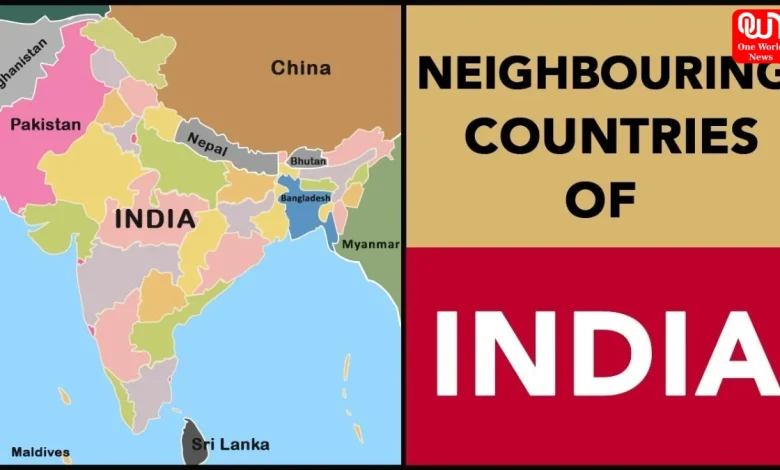India Neighbouring Countries: Complete List with Boundaries and Names

India Neighbouring Countries: Detailed List of Borders, Capitals, and Geographic Importance with Boundary Information
India, the seventh-largest country in the world, shares its international boundaries with several countries in South Asia. These India Neighbouring Countries play a vital role in shaping India’s geographical, cultural, and political landscape. India has a land boundary of approximately 15,106 kilometers and a coastline of 7,516 kilometers, connecting it to both land and maritime neighbors.
Overview of India’s Boundaries
Total Boundary Length
India shares its borders with seven countries by land and two by sea. The total land boundary stretches across mountains, deserts, forests, and rivers, making it one of the most diverse and strategically significant borders in the world.
Importance of India’s Neighbouring Countries
The India Neighbouring Countries hold geopolitical, economic, and cultural importance. These nations influence India’s trade, defense, foreign policy, and regional partnerships. Maintaining peaceful and cooperative relations with its neighbors remains a key aspect of India’s diplomacy.
List of India Neighbouring Countries
1. Pakistan
India shares its western border with Pakistan. The India-Pakistan boundary extends approximately 3,323 kilometers, running through the states of Gujarat, Rajasthan, Punjab, and Jammu & Kashmir. The boundary is divided into three main segments: the International Border, the Line of Control (LoC), and the Actual Ground Position Line (AGPL) in the Siachen region. Pakistan’s capital is Islamabad, and the two nations share deep historical and cultural ties despite political differences.
2. China
To the north, India shares a long and complex border with China, stretching about 3,488 kilometers. The India-China border passes through the union territories of Ladakh and Arunachal Pradesh, as well as the states of Sikkim, Himachal Pradesh, and Uttarakhand. This boundary is often referred to as the Line of Actual Control (LAC). China’s capital is Beijing. India’s relationship with China includes both cooperation and competition in trade, defense, and regional influence.
3. Nepal
Nepal lies to the north of India, sharing an open border of about 1,751 kilometers. The boundary runs along the Indian states of Sikkim, West Bengal, Bihar, and Uttar Pradesh. Kathmandu is Nepal’s capital city. India and Nepal share strong cultural, religious, and economic relations, as well as a special treaty that allows citizens of both countries to travel and work freely across borders.
4. Bhutan
India and Bhutan share a 699-kilometer border along the northeastern part of India, adjacent to the states of Sikkim, West Bengal, Assam, and Arunachal Pradesh. Thimphu is the capital of Bhutan. The two nations enjoy cordial relations marked by trade cooperation, cultural exchange, and mutual respect for sovereignty. Bhutan’s friendship is one of the cornerstones of India’s neighborhood policy.
Read more: Hailey Bieber Birthday 2025: A Glamorous Celebration of Style, Love, and Success
5. Bangladesh
Bangladesh shares the longest boundary with India, stretching about 4,096 kilometers. The border touches the Indian states of West Bengal, Assam, Meghalaya, Mizoram, and Tripura. Dhaka is the capital of Bangladesh. This border is known for its rivers and trade routes, making Bangladesh one of the most significant India Neighbouring Countries in terms of economic and cultural exchange.
6. Myanmar
India shares its eastern boundary with Myanmar, extending around 1,643 kilometers. The border passes through the Indian states of Arunachal Pradesh, Nagaland, Manipur, and Mizoram. Naypyidaw is Myanmar’s capital. The two countries share strong cultural and trade connections, and the border region is crucial for India’s “Act East Policy.”
7. Afghanistan
Although India and Afghanistan do not currently share a direct land border due to Pakistan-occupied Kashmir, Afghanistan is traditionally considered one of the India Neighbouring Countries. The historical boundary, known as the Durand Line, connects the two nations through cultural and economic ties. Kabul is the capital of Afghanistan, and both nations share a long history of trade and cultural exchange.
India’s Maritime Neighbours
Sri Lanka
Sri Lanka lies to the south of India, separated by the Palk Strait and the Gulf of Mannar. The closest distance between the two countries is about 30 kilometers. Colombo is Sri Lanka’s capital, and the two nations are connected by strong cultural, religious, and economic ties dating back centuries.
Maldives
The Maldives is another maritime neighbor of India, located southwest of Kerala in the Arabian Sea. The distance between India and Maldives is approximately 700 kilometers. Malé is the capital of Maldives. The two nations share strong diplomatic, tourism, and trade relationships.
Geographical and Cultural Significance
Diversity in Landscapes and Borders
India’s borders pass through a variety of terrains—mountain ranges like the Himalayas in the north, desert regions in the west, and tropical forests in the east. This diversity adds to India’s rich geographical and cultural identity.
Political and Economic Relations
Maintaining stable relations with India Neighbouring Countries is essential for regional peace and prosperity. India’s collaborations include trade agreements, cultural exchanges, and defense partnerships that strengthen ties across South Asia.
Read more: Virat Kohli’s Birthday 2025: Celebrating the Journey of India’s Cricket Icon
Strategic Importance
India’s location makes it a central power in South Asia. Its borders with nations like China and Pakistan are of immense strategic value, while relations with Bangladesh, Nepal, and Bhutan ensure regional stability and cooperation.
Conclusion
India Neighbouring Countries define its identity as a regional power and cultural hub in South Asia. From shared history and traditions to modern economic cooperation, these borders represent more than geography—they symbolize connection, diversity, and diplomacy. Understanding India’s neighboring nations helps appreciate the country’s geopolitical importance and its role in maintaining peace and unity across the region.
We’re now on WhatsApp. Click to join.
Like this post?
Register at One World News to never miss out on videos, celeb interviews, and best reads.







